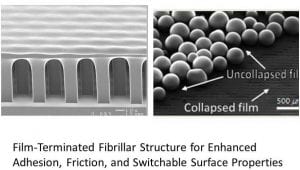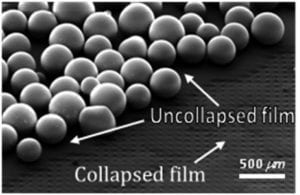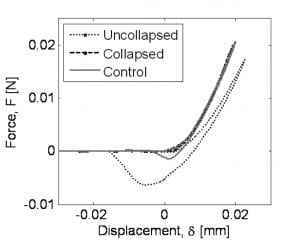Use of wrinkled surfaces of oxidized PDMS to create mechanically tunable adhesion:
Our film-terminated structure can exist in two metastable states. The uncollapsed state has strongly enhanced adhesion because of a crack-trapping mechanism whereas the collapsed state, resembling a rough surface, has very low adhesion. The structure can be repeatedly switched between the two states, allowing active control of adhesion and friction.
Nadermann et al. (Langmuir 2010).
Effect of surface stress on roughness and adhesion of soft solids
Most established theories on adhesion of rough materials predict that higher roughness results in lower adhesion due to reduction of real area of contact and elastic energy stored in deformation and flattening of asperities. For example, Persson’s energy argument for adhesion of rough surfaces proposes that the elastic energy to flatten surface roughness is released on interfacial crack propagation, and thus should be subtracted from work of adhesion. Contrary to most established theories, Guduru argues that roughness can actually strongly increase adhesion due to additional energy dissipation during intermittent crack trapping and unstable release. Surface stress can also affect deformation of a soft solid due to electrocapillarity by flattening the roughness. Hui et. al. theoretically account for the effect of surface stress flattening the soft solid on adhesion of rough materials. However, the effect of surface stress has not been investigated experimentally.
In this study we systematically investigate the effect of surface stress on adhesion of a rough soft solid. We perform adhesion testing with a thin polydimethylsiloxane (PDMS) beam sample on top of a thick gelatin sample using a double cantilever beam experiment with one cantilever fixed. We chose four configurations: smooth PDMS on smooth gelatin, rough PDMS on smooth gelatin, smooth PDMS on rough gelatin and rough PDMS on rough gelatin.
From our preliminary experiments we observe a smaller crack length for smooth PDMS- rough gelatin samples than for smooth PDMS-smooth gelatin ones. This indicates higher adhesion for the rougher sample. This result is in contradiction of the well-known Persson’s theory. We are investigating physical effects to explain our results.




